Milan have turned into one of the most dominant teams in the 2020/21 season, keeping their leadership in Serie A round after round and currently sitting two points clear at the top. Their latest displays weren’t as impressive as they fell victim to Atalanta and saw their second league defeat, just to go out for the Coppa Italia derby with city rivals Inter and make it two consecutive defeats.
The team were clearly struggling in ball progression and in the final third and couldn’t create enough opportunities to threaten the opposition’s goal in both games. Stefano Pioli’s men looked desperate as never before trying to resist their opponents’ attacking ventures but also in trying to bypass the press and create danger when in possession.
Their efforts weren’t successful and saw them crash out of the Coppa Italia battle which was a huge disappointment after their goalless performance against Atalanta.
In this tactical analysis in the form of scout report, we will look into their tactics from the last couple of games and use analysis to determine whether their performance was a coincidence or they are struggling in certain areas.
Atalanta’s pressing limited Milan and tested out their creativity
With a couple of absent regular starters in the face of Hakan Çalhanoğlu and Alessio Romagnoli, Pioli still opted for his usual 4-2-3-1 against Atalanta’s favoured 3-4-1-2 formation. Looking at their strategies, on paper, both teams should’ve been able to find their way forward and create opportunities. That wasn’t the case though. Milan’s usually versatile build-up movement wasn’t very effective and failed to break Atalanta’s pressing structures.
While the team were dominating with their attacking movement in the first half of the season, they now often find it hard to penetrate their opponents’ defensive set-ups. Being aware of Atalanta’s aggressive man-to-man marking, Milan had come up with a strict plan in efforts to reach the final third. Initially, they focused on overloading the right side, providing more space and freedom for the left-back Theo Hernández, who is one of their main figures in attack.
Switch of play is an approach that Milan have relied on multiple times throughout the season but wasn’t quite successful against La Dea. They became predictable and often failed to capitalise on these opportunities both due to Atalanta’s disciplined marking strategy and Milan’s lack of strong actions in the final third. Hernández couldn’t create quality opportunities and lost possession frequently which resulted in multiple unsuccessful attacking movements that were ended early on.
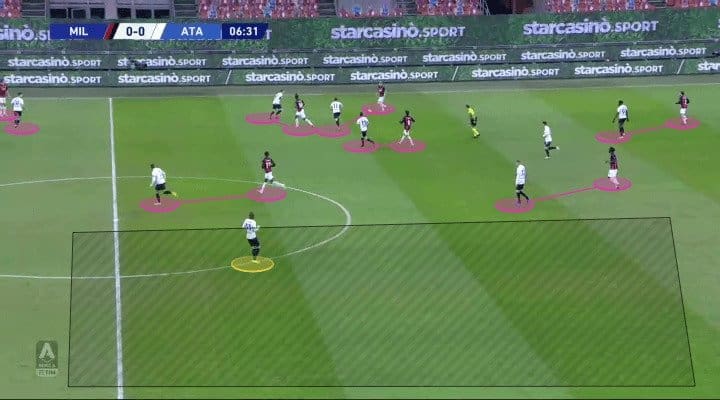
That is not an unusual event against Gian Piero Gasperini’s side though. They usually put a lot of efforts into their press and actions off the ball and always try to block the passing lanes in the central areas. While they allowed Milan some chances at the beginning of the game, they adjusted their pressing even better and troubled Milan’s build-up from the back.
With their tight man-to-man marking the Rossoneri were unable to find channels for ball progression and weren’t able to open the passing lanes with movement off the ball. This forced Milan to use a lot more long balls than usual, which dropped their efficiency in attack immensely. While they do have a great target man in Zlatan Ibrahimović, Atalanta’s constant pressure didn’t allow them to hold on to the ball and create chances. This even got the keeper Gianluigi Donnarumma involved in the ball progression and he ended the game with four long passes to the Swede in efforts to bypass the press and send the ball behind La Dea’s defence.
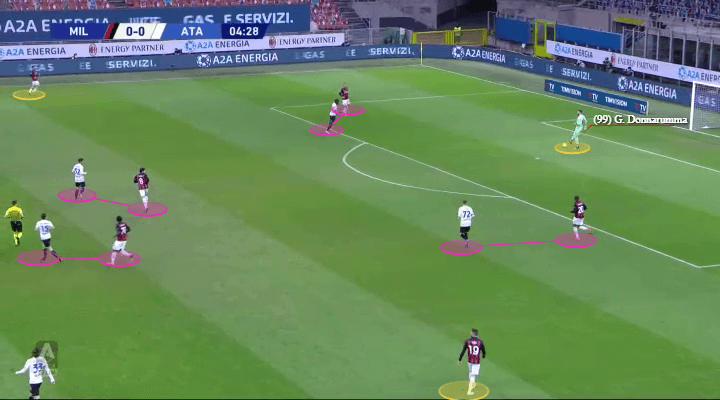
Milan struggled defensively too. Their opponents showcased their infamous attacking style involving a lot of movement on and off the ball. They were able to create spaces in key areas and exploit them with quick combinations, something that the Rossoneri couldn’t deal with. Their marking strategy wasn’t as successful and they often allowed being engaged on one side, while leaving opposite players uncovered in the advanced areas. This allowed Atalanta to progress the ball through certain channels but also to break Milan’s defensive overload thanks to the movement in and around the box. Milan’s actions and decision-making under pressure turned out as the main problem both in their defensive and in their attacking actions.
Hernández’ defensive movement caused Milan some trouble too. Due to his attacking role, his position was often freed up, leaving space for Atalanta to exploit. His actions whenever he was able to drop back weren’t always accurate either. He would go out to cover the wing-back Hateboer, which would’ve been a smart move if the rest of the defence weren’t staying narrow. That wasn’t the case, though. The defence would re-organise properly, leaving gaps for La Dea’s players to expose. With the differences in their set-ups, Milan’s midfield should’ve been more supportive defensively.
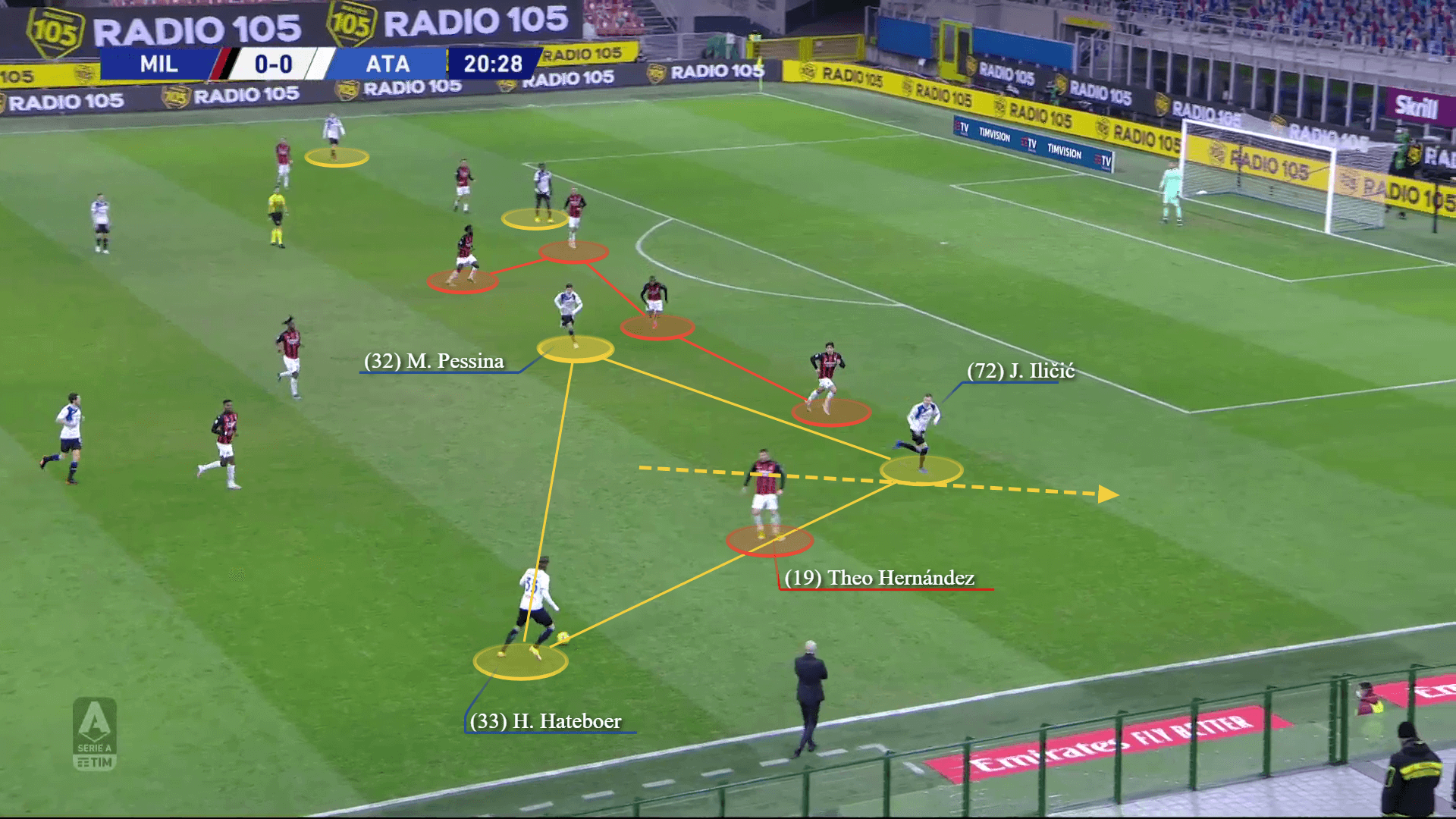
While Sandro Tonali and Franck Kessié did drop deeper to provide additional defensive support and ball progression options, Matteo Pessina and Marten de Roon were instructed to mark them tightly so their space for movement is limited. Milan tried to outnumber Atalanta while still in their own half, using the six field players and the goalkeeper to help with the build-up.
Due to La Dea’s defensive organisation, the Rossoneri were able to create only one counter-attack which didn’t lead to a dangerous chance. This is a testimony to Atalanta’s successful pressing and movement since they stopped one of the most prolific counter-attacking teams.
How Inter stole control of the game?
Against Inter, thinks looked differently. Using the same formation against Antonio Conte’s 3-5-2 was working well in the first half and Milan seemed to have control over the game. The Nerazzurri weren’t very aggressive with their press, adjusting to the opposition’s movement as they did in their win against Juventus. This meant that they wouldn’t press high and would rather stay midway and try to outplay Milan there.
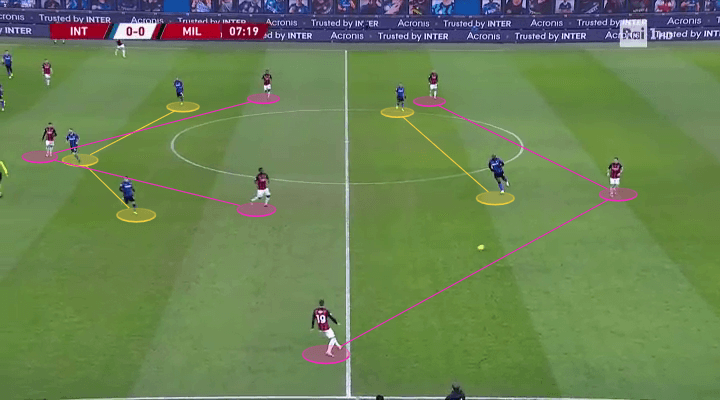
Contrary to them, Milan pushed a lot higher and focused on troubling Inter’s build-up from the back. Brahim Díaz was assigned the task of covering Marcelo Brozović who is Inter’s most important player for ball progression. Due to Milan’s high press and tight coverage of Brozović, Inter quickly had to change their strategy and start advancing the ball through the flanks. After going 0-1 down, the Nerrazzuri adjusted their press and started pushing up high. They were driven to gain back possession as quickly as possible and recover the ball in the advanced areas. It looked like these actions would allow Milan many chances on the counter, and it did allow them more opportunities to expose the opposition, but Inter’s defensive movement was adequate enough and they managed to quickly regroup and structure well in these situations.
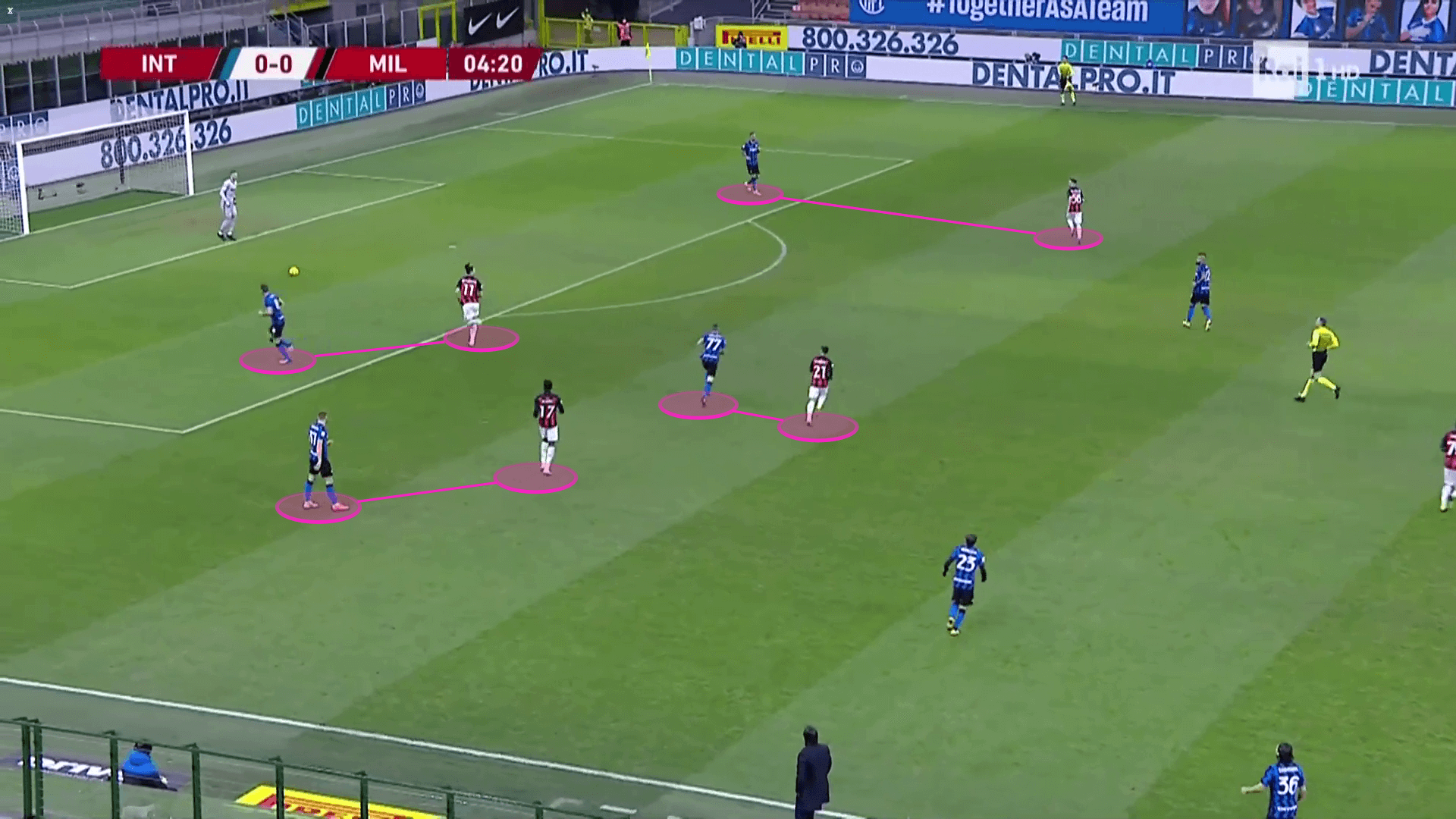
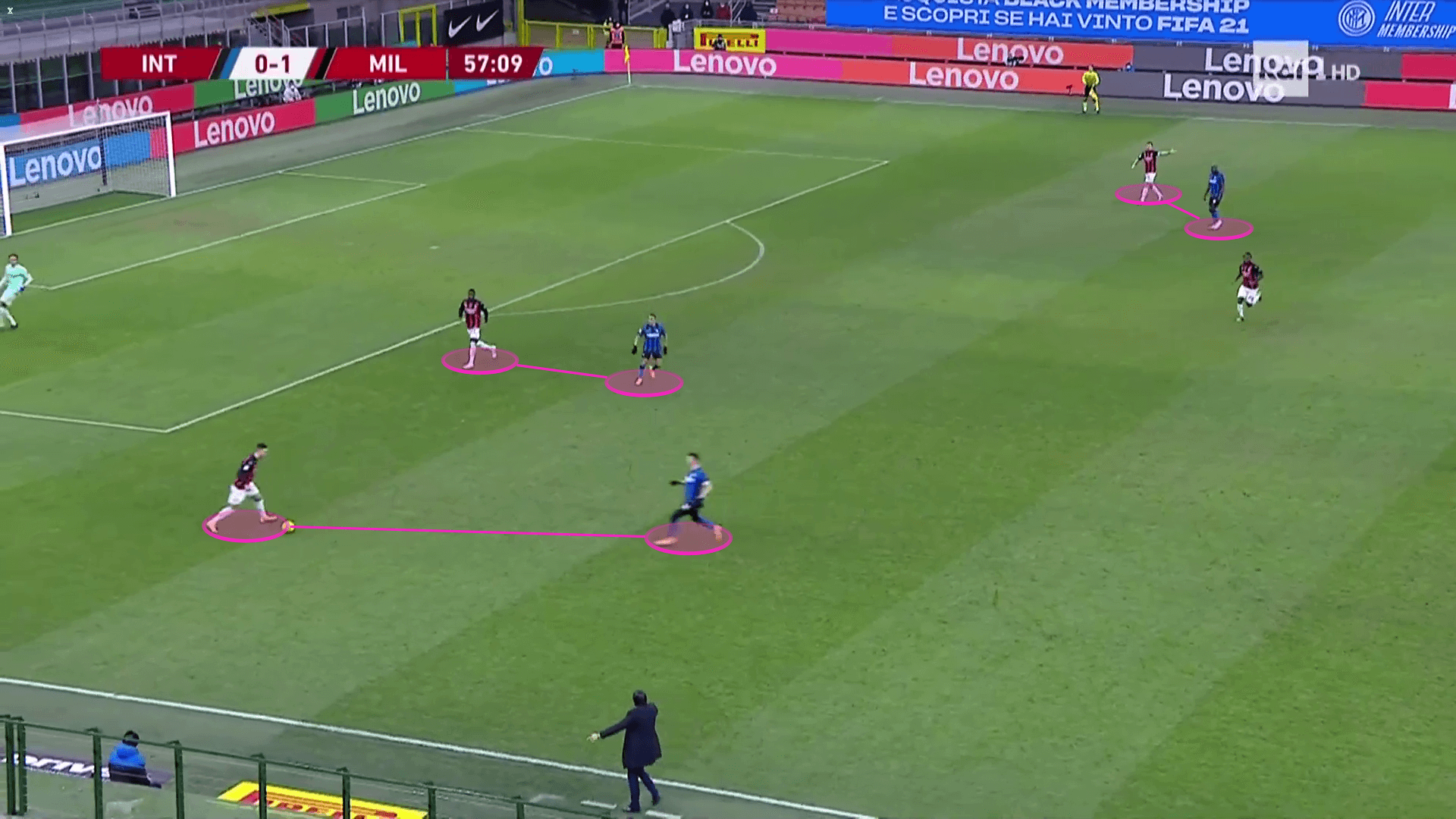
Pushing high was their strategy in possession too. Inter’s midfielders were very attack-oriented and were focused on moving off the ball, occupying the key areas in the final third, most frequently making runs to the box so they can take advantage of the crosses. Ivan Perišić was very active on the left, disturbing Milan’s defence, while Matteo Darmian and Nicolò Barella would often combine on the right. Romelu Lukaku would join them in efforts to expose Hernández and create spaces through a lot of movement and link-up-play.
Inter had their chances in front of the goal in the first half but a combination of shot inaccuracy and Milan’s defensive actions restrained them from scoring. Alessio Romagnoli supported by Kessié did a good job preventing Lukaku from creating any danger in the first half.
Rafael Leão was the player to disturb Inter’s defence the most and create a partnership with the left-back where they would often combine in efforts to break through the Nerrazzuri’s defence.
Things changed completely when Ibrahimović saw red card ten minutes into the second half. Their rivals took the opportunity to pin them back and push higher, creating as many opportunities as possible. This limited Milan’s movement completely and they didn’t have many opportunities to go forward. Even if they managed to escape the press, the poor ball control and work under pressure would result in failure to create something out of it.
Although they did struggle, sitting back and defending with almost all players behind the ball was a decent strategy having in mind their one-goal advantage. They didn’t have a plan on how to escape the pressure though and it respectively led to more individual mistakes and inaccurate movement. They started cracking under pressure and conceded 19 shots in the second half, while not being able to threaten Inter’s goal even once. Inter were determined to get the most out of the situation.
Player dependency
Hakan Çalhanoğlu absence has been some of the biggest difficulties Milan had to overcome. The Turkish international has been the key player that holds the Rossoneri’s lines together and helps immensely in their attacking actions since his arrival at the club and that became extremely noticeable in their last couple of games.
His absence from the attacking midfield position made Milan’s build-up efforts unsuccessful and decreased their efficiency in the final third. His strong positioning and presence in the central areas turned out to be irreplaceable and key for each build-up strategy they opt for. Milan not only struggled in opening the passing lanes and bypassing the press, but their counter-attacking actions suffered without him.
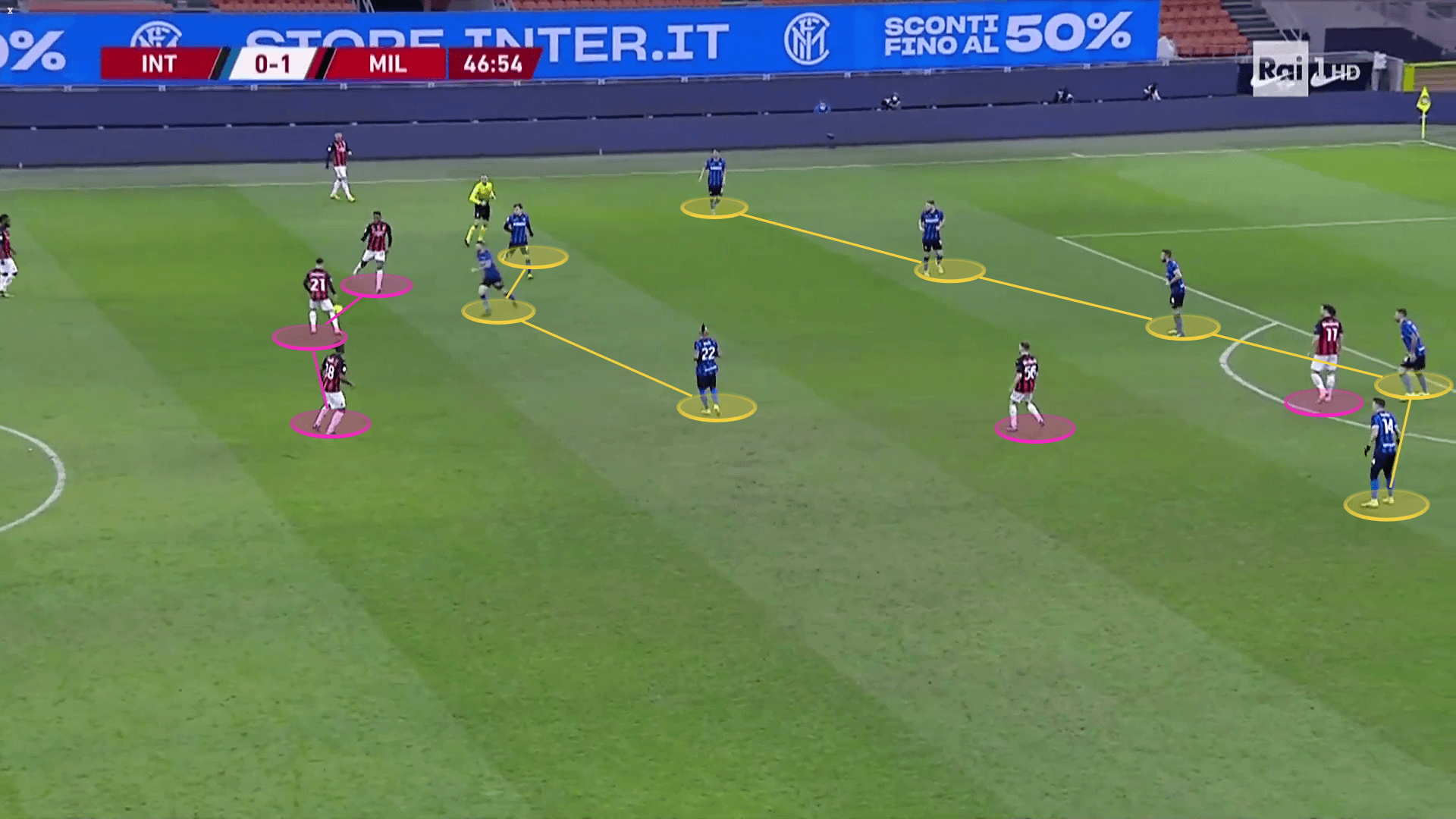
This raised some eyebrows on whether the team’s dependency on certain figures isn’t too high, making them unable to conquer pressing teams in their absence.
Soualiho Meïté’s role ahead of Díaz in efforts to increase their attacking efficiency was clearly inefficient which made the team miss Çalhanoğlu even more. Pioli’s experiment turned out unsuccessful and proved that the team should rather stick to their strengths than thinking of too unusual ways to expose them.
The combination of not having both Çalhanoğlu and Ibrahimović against Inter showed that they struggle with building a connection between the lines and made their efforts through the central areas inadequate. Of course, being a man down is a huge disadvantage but their inability to reorganise might be a red flag for their future.
Ismaël Bennacer’s injury in December was a huge blow for the Rossoneri and it definitely affected their performance in midfield. His actions in the central areas would often help the team outplay the opposition and would’ve been very useful against Atalanta’s and Inter’s pressing strategies.
Pioli had to deal with a few missing players lately and it has been worrying that their performance has dropped, being an indicator of inflexibility, which could cause them trouble until the end of the season.
Conclusion
Milan do not necessarily have problems against pressing teams, but they do experience struggles in the absence of certain players. That’s a red flag for the team and a hit on their title ambitions since this affects their performance and they slowly start losing momentum. Their dependency on a few players would make their actions irrelevant against teams that try to pin them back as in their absence they would struggle in creating a connection between the lines and handling the pressure which would respectively lead to both individual and team errors.
The team’s future now depends on how quickly their key players will return to regular actions, otherwise they risk losing what they have built so far.






Comments